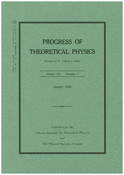-
PDF
- Split View
-
Views
-
Cite
Cite
Yuichiro Kiyo, Takuya Morozumi, Paulo Parada, Margarida N. Rebelo, Morimitsu Tanimoto, Quark Mass Hierarchy, FCNC and CP Violation in a Seesaw Model, Progress of Theoretical Physics, Volume 101, Issue 3, March 1999, Pages 671–706, https://doi.org/10.1143/PTP.101.671
Close - Share Icon Share
Abstract
The seesaw model of quark masses is studied systematically, focusing on its developments. A framework in which the top quark mass is allowed to be of the order of the electroweak symmetry breaking scale, while the remaining light quarks have much smaller masses, due to the seesaw mechanism, is presented. The violation of the GIM mechanism is shown to be small and the tree level FCNC are suppressed naturally. In this model, there are many particles which could contribute to the FCNC in the one-loop level. The parameters of the model are constrained by using the experimental data on  mixing and εK. The rare K meson decays
mixing and εK. The rare K meson decays  and
and  are also investigated in the model. In these processes the scalar operators
are also investigated in the model. In these processes the scalar operators 
 , which are derived from box diagrams in the model, play an important role due to the enhancement factor MK/ms in the matrix element
, which are derived from box diagrams in the model, play an important role due to the enhancement factor MK/ms in the matrix element  . It is emphasized that the KL decay process through the scalar operator is not the CP-violating mode, so
. It is emphasized that the KL decay process through the scalar operator is not the CP-violating mode, so  remains non-zero even in the CP-conserved limit. The pion energy spectra for these processes are predicted.
remains non-zero even in the CP-conserved limit. The pion energy spectra for these processes are predicted.
References
Citing Article(s):
Progress of Theoretical Physics Vol. 103 No. 2 (2000) pp. 379–391
Neutrino Mixing in the Seesaw Model Junya Hashida, Takuya Morozumi and Agus Purwanto



